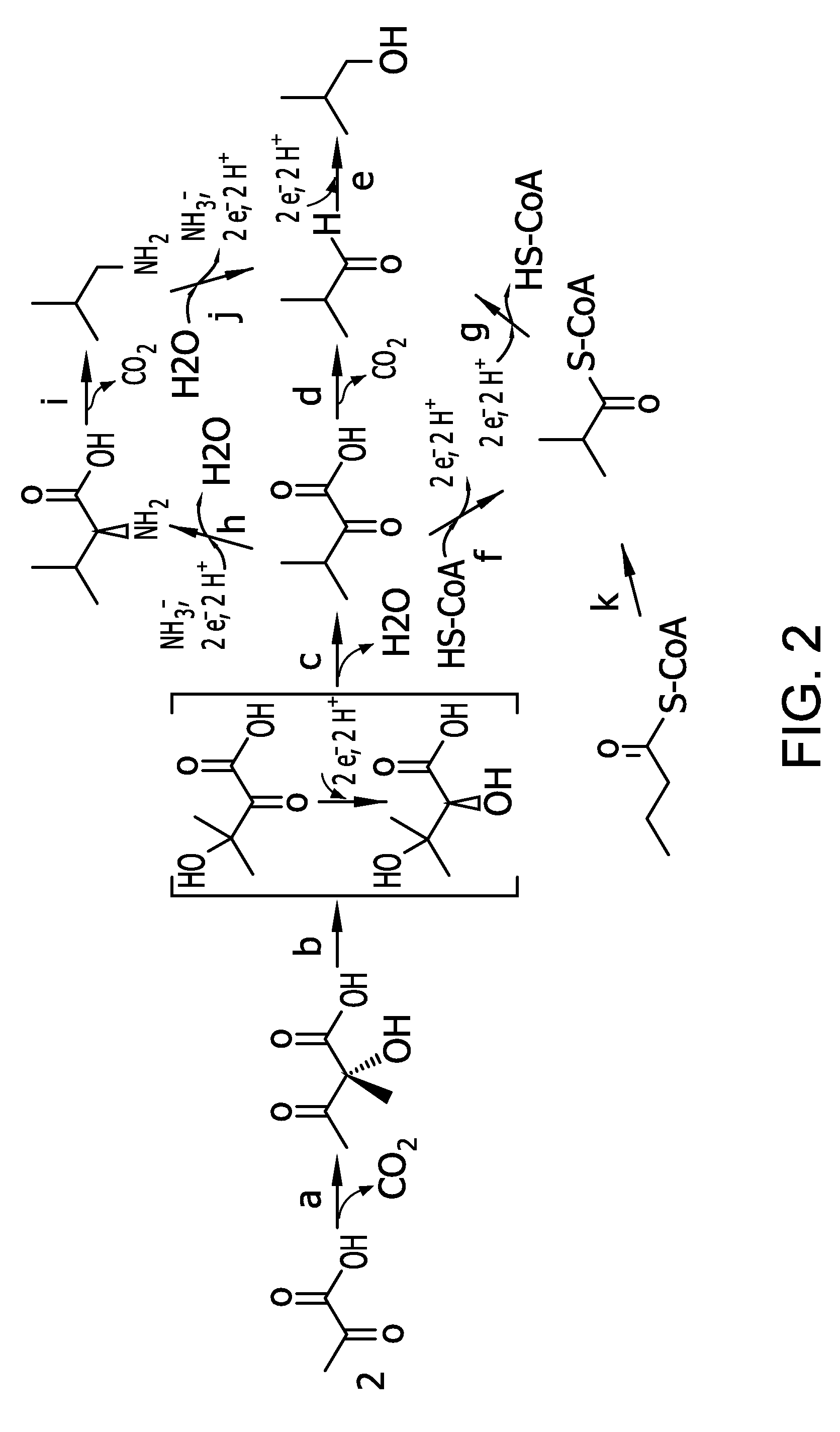Flux to acetolactate-derived products in lactic acid bacteria
a technology acetolactate, which is applied in the field of industrial microbiology and the metabolism can solve the problems of unpredictable pyruvate reversal by metabolic engineering to other products of lactic acid bacteria, ldh-deficient ethanol production, and insignificant improvement of carbon flow toward ethanol, so as to reduce or eliminate acetolactate decarboxylase activity and eliminate lactate dehydrogenase activity
- Summary
- Abstract
- Description
- Claims
- Application Information
AI Technical Summary
Benefits of technology
Problems solved by technology
Method used
Image
Examples
example 1
Construction of the ilvD Integration Vector and PN0512ΔldhDΔldhL1::ilvDLl+ Integration Strain
[0165]This example describes integration of the Lactococcus lactis ilvD gene into the chromosome of L. plantarum strain PN0512 ΔldhDΔldhL1 for expression of DHAD. The construction of L. plantarum PN0512 ΔldhDΔldhL1 was described in Example 1 of co-pending U.S. patent application Ser. No. 61 / 100,786, which is herein incorporated by reference. This strain is deleted for the two genes that encode the major lactate dehydrogenases: ldhD and ldhL1. The double deletion was made in Lactobacillus plantarum PN0512 (ATCC strain #PTA-7727).
[0166]Gene knockouts were constructed using a process based on a two-step homologous recombination procedure to yield unmarked gene deletions (Ferain et al., 1994, J. Bact. 176:596). The procedure utilized a shuttle vector, pFP996 (SEQ ID NO:97). pFP996 is a shuttle vector for gram-positive bacteria. It can replicate in both E. coli and gram-positive bacteria. It cont...
example 2
Construction of a suf Operon Promoter Integration Vector and PN0512ΔldhDΔldhL1::ilvDLl+ suf::P5P4+ Integration Strain
[0180]This Example describes integration of two promoters into the chromosome of L. plantarum PN0512ΔldhDΔldhL1::ilvDLl+. The promoters were integrated upstream of the suf operon, whose gene products are responsible for Fe—S cluster assembly. The promoter integration results in a strain with increased expression of the endogenous Fe—S cluster machinery.
[0181]The suf operon chromosomal promoter integration was constructed by a two-step homologous recombination procedure to yield an unmarked integration using the shuttle vector pFP996 (SEQ ID NO:97) as described above.
[0182]The suf operon promoter integration vector was constructed in three steps. In the first step, a right homologous arm fragment containing the 5′ portion of the suf operon (sufC and part of sufD) was cloned into pFP996. In the second step, the synthetic promoters P5 and P4 [Rud et al., Microbiology (20...
example 3
Construction of the Tn5-Transposon Vector (pTN6) and its Use for Integration of PgroE-kivD(o)-sadB(o) Cassette
[0185]Tn5 is a bacterial transposon which has been well characterized in E. coli (Johnson & Reznikoff, Nature (1983) 304:280-282). A Tn5-mediated transposition system for lactic acid bacteria (LAB), however, has not been reported so far. In this Example, use of a Tn5-transposon vector as a delivery system for random gene integration into the chromosome of LAB was developed. The developed Tn5-transposon vector (pTN6) (SEQ ID NO:137) is an E. coli-L. plantarum shuttle vector. Plasmid pTN6 contains a transposase gene (tnp), transposase recognition nucleotide sequences Tn5IE (19 base pairs inside end) and Tn5OE (19 base pairs outside end), two antibiotic resistance markers; one for resistance to chloramphenicol and the other for resistance to erythromycin, P15A replication origin for E. coli, pE194 replication origin for L. plantarum which is temperature sensitive (Horinouchi an...
PUM
| Property | Measurement | Unit |
|---|---|---|
| temperature | aaaaa | aaaaa |
| temperature | aaaaa | aaaaa |
| temperature | aaaaa | aaaaa |
Abstract
Description
Claims
Application Information
 Login to View More
Login to View More - R&D
- Intellectual Property
- Life Sciences
- Materials
- Tech Scout
- Unparalleled Data Quality
- Higher Quality Content
- 60% Fewer Hallucinations
Browse by: Latest US Patents, China's latest patents, Technical Efficacy Thesaurus, Application Domain, Technology Topic, Popular Technical Reports.
© 2025 PatSnap. All rights reserved.Legal|Privacy policy|Modern Slavery Act Transparency Statement|Sitemap|About US| Contact US: help@patsnap.com


